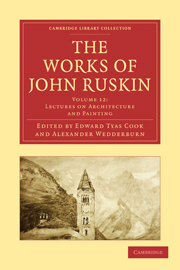Book contents
- Frontmatter
- Contents
- LIST OF ILLUSTRATIONS
- INTRODUCTION TO THIS VOLUME
- PART I “LECTURES ON ARCHITECTURE AND PAINTING” (1854)
- PART II REVIEWS, LETTERS, AND PAMPHLETS ON ART (1844–1854)
- APPENDIX TO PART II
- I LETTERS ON PAINTED GLASS (1844)
- II NOTES ON THE LOUVRE (1844, 1849, 1854)
- III ADDRESSES ON COLOUR AND ILLUMINATION (1854)
- PART III “NOTES ON THE CONSTRUCTION OF SHEEPFOLDS” (1851)
- APPENDIX TO PART III
- PART IV LETTERS ON POLITICS (1852)
- Plate section
III - ADDRESSES ON COLOUR AND ILLUMINATION (1854)
Published online by Cambridge University Press: 05 November 2011
- Frontmatter
- Contents
- LIST OF ILLUSTRATIONS
- INTRODUCTION TO THIS VOLUME
- PART I “LECTURES ON ARCHITECTURE AND PAINTING” (1854)
- PART II REVIEWS, LETTERS, AND PAMPHLETS ON ART (1844–1854)
- APPENDIX TO PART II
- I LETTERS ON PAINTED GLASS (1844)
- II NOTES ON THE LOUVRE (1844, 1849, 1854)
- III ADDRESSES ON COLOUR AND ILLUMINATION (1854)
- PART III “NOTES ON THE CONSTRUCTION OF SHEEPFOLDS” (1851)
- APPENDIX TO PART III
- PART IV LETTERS ON POLITICS (1852)
- Plate section
Summary
THE DISTINCTION BETWEEN ILLUMINATION AND PAINTING
[Delivered on Saturday, November 11th, 1854]
1. Mr. Ruskin commenced by stating that he was not going to read a paper, or to speak from notes, and it was a mistake in the advertisement to say that he intended to deliver a lecture. It was not a lecture, but a little friendly talk, and his object was to address himself to the students present, and place before them, in a familiar way, things which were useful.
Before entering upon this subject, however, he wished to glance at one or two historical points, with the view of explaining the examples he proposed to set before them. In these days it was a very common practice to laugh at the Middle Ages and hold them up to ridicule. Truly they were ridiculous in many senses, but certainly they were not ridiculous in their way of writing. They did not write in those days so much as we do now, but they wrote much better when they did write. Even so far back as the seventh century, the Saxon writing began to acquire character and dignity and beauty, though the writing of that period differed materially from anything that we did now. The specimen he now submitted (an initial letter) was written as an ornament to a psalter belonging to a lady who died in the year 656, St. Salaberga. It would be perceived that the colours employed in writing in that day were simply black, yellow and red.
- Type
- Chapter
- Information
- The Works of John Ruskin , pp. 474 - 508Publisher: Cambridge University PressPrint publication year: 2010First published in: 1903

